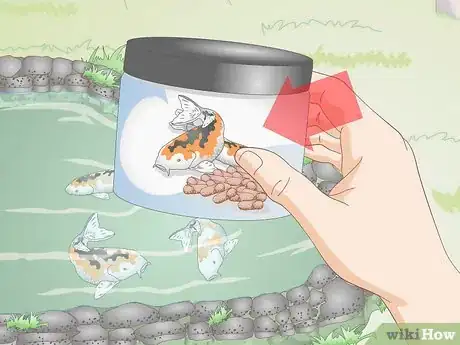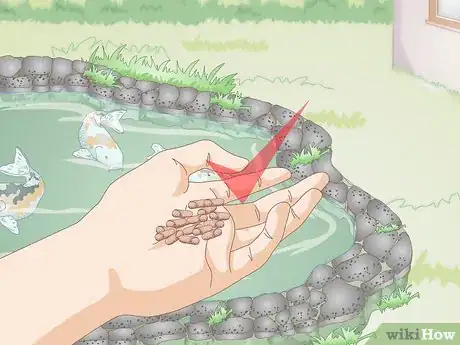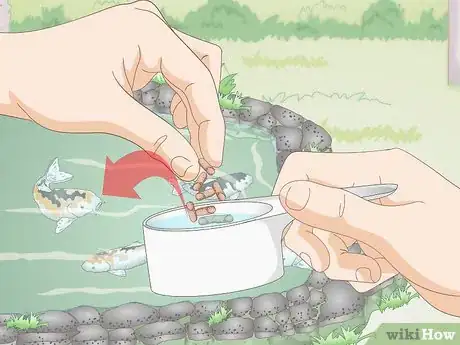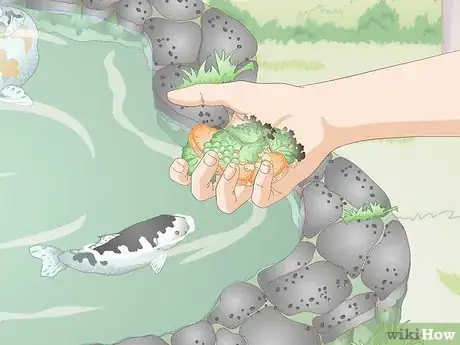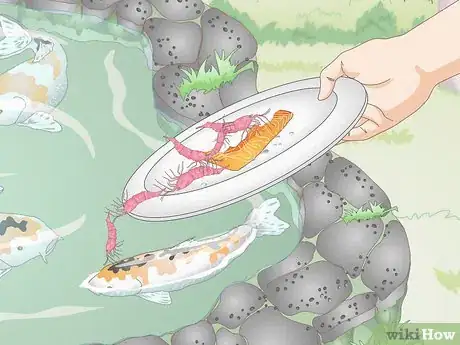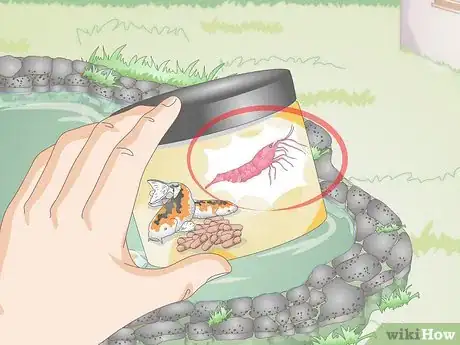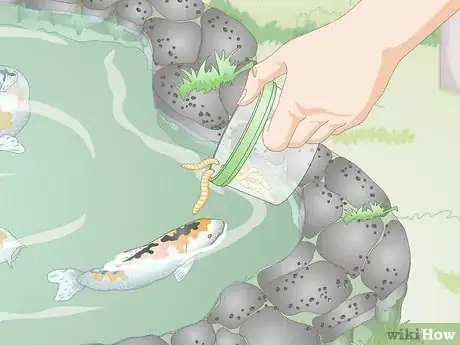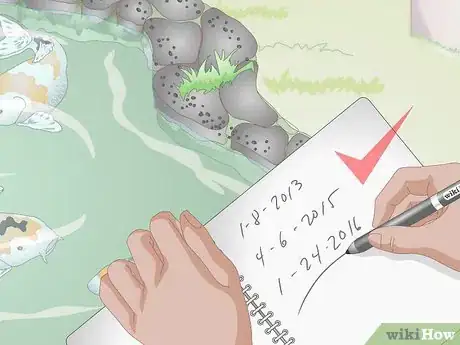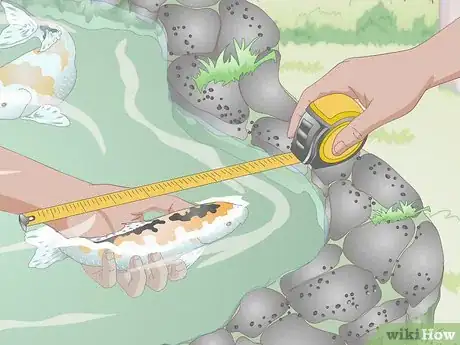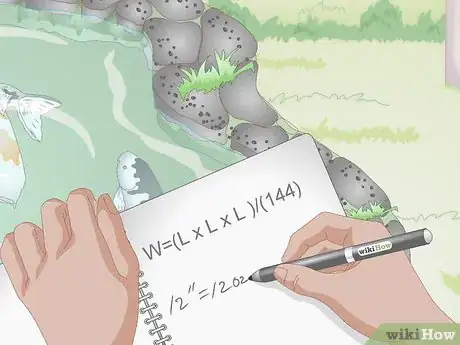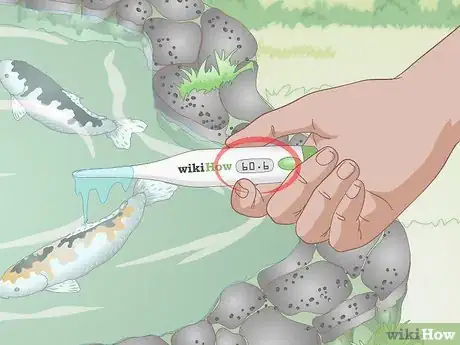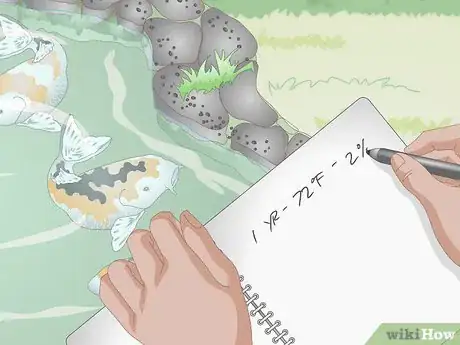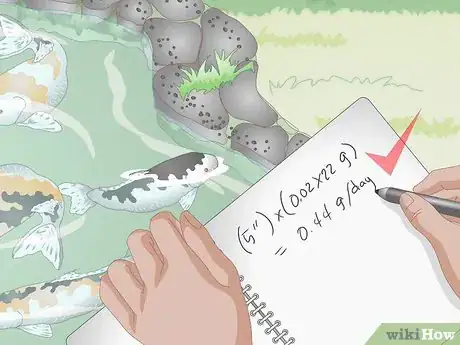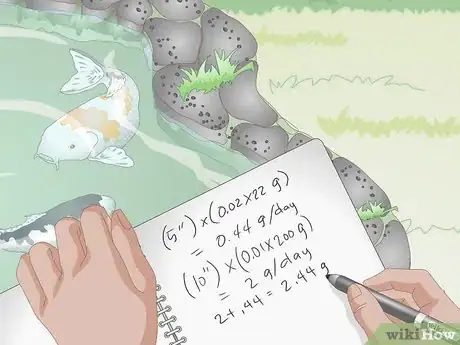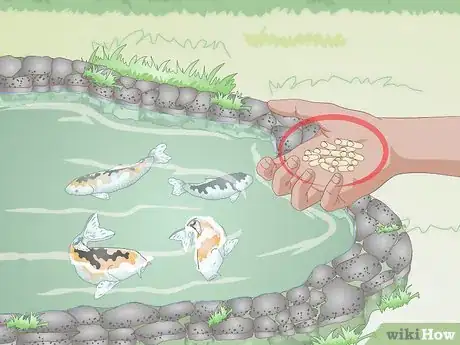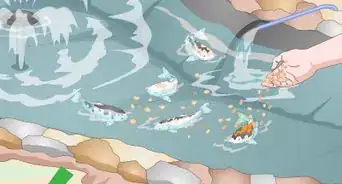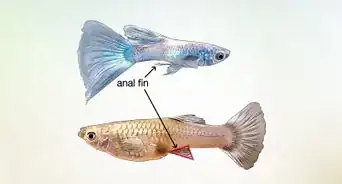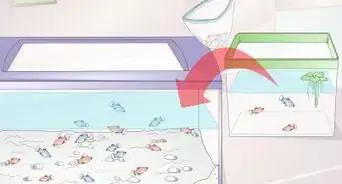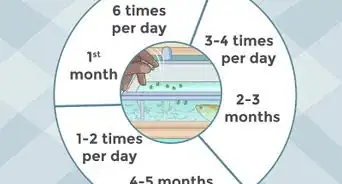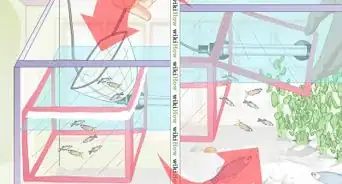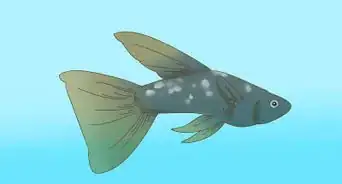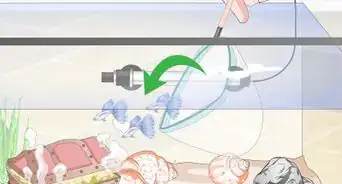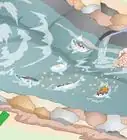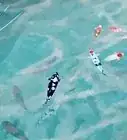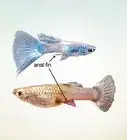This article was co-authored by wikiHow Staff. Our trained team of editors and researchers validate articles for accuracy and comprehensiveness. wikiHow's Content Management Team carefully monitors the work from our editorial staff to ensure that each article is backed by trusted research and meets our high quality standards.
This article has been viewed 35,508 times.
Learn more...
A koi’s natural environment provides a variety of food sources that meet all the dietary requirements they need to grow and be healthy. Ornamental ponds, however, do not meet all of these requirements through pond food sources alone. For this reason, it is important to learn how to properly feed your koi to ensure they are receiving all the nutrients they need to thrive.[1]
Steps
Providing a Base Diet
-
1Choose a quality pellet. When deciding what to feed your koi, think of it in two parts—base diet and supplementary diet. The base diet should provide all the essential proteins, fats, and most of the vitamins and minerals your koi need to survive. Commercial pellet food is the most reliable, convenient, and healthy option for a base diet.
- The protein content in food pellets should be at least 30 percent. Protein content in pellets varies greatly depending on manufacturer—usually between 25 and 36 percent—so read labels before deciding.
- The primary source of protein should be fish meal or soybean meal.
- The fat content (from fish oil) in the pellets should be at least 5 percent.[2]
-
2Feed koi small pellets. Food pellets come in a variety of sizes and you might think the bigger the pellet, the more nutrients it contains. This, however, is not the case. Small pellets provide the same nutritional content as large ones and are easier for koi to ingest and digest, reducing the danger of intestinal impaction.[3]Advertisement
-
3Soak pellets in pond water. Before feeding your koi, soak their food pellets in pond water for at least 30 seconds to one minute. This will make them safer and easier to digest.
- This step is especially important when the feeding frequency is low or fish are especially hungry, otherwise, they may consume the pellets too quickly and end up eating dry pellets. Dry food can expand in the digestive track, increasing the risk for life-threatening internal blockages.[4]
Supplementing the Base Diet
-
1Include natural pond plants and scraps. Variety is important in a well-rounded diet. While the supplemental diet provides many of the same nutrients found in the base diet, it also provides a variety of other nutrients essential to your koi’s health. To increase variety, feed your koi natural pond plants and food scraps.
- Natural pond plants include ordinary pond algae, as well as other plants like duckweed.
- Vegetable scraps like peas, carrots, spinach, leaf lettuce, and so on, are also a good choice for supplementation.[5]
-
2Provide shrimp on occasion. Frozen shrimp can be used as a protein supplement. However, they should be used sparingly.
- Some people also provide scraps from fish they have prepared for their own meals as an occasional dietary supplement.[6]
-
3Add color-enhancing foods. Of course, koi are best-known for their beautiful colors. You can help preserve and enhance their color by feeding them color-enhancing foods every four weeks.
- Look for foods that contain spirulina, shrimp, or krill.
- In the wild, koi eat crayfish, which are high in carotenoids, an important nutrient for enhancing the color red.[7]
-
4Feed koi live foods. Koi may enjoy eating live foods from time to time, like they do in the wild, as a special treat. This can also be a good way to supplement their base diet.
- Feed koi crustaceans, insect larvae, worms, and aquatic plants.
- Also include live plants to give koi some roughage and added vitamins and minerals.
Determining How Much to Feed
-
1Keep track of age. In order to determine the correct amount to feed your koi, you need to know the age, length, and weight of each fish in your pond, in addition to the water temperature. Find out how old your koi are when you purchase them and keep track of their age over the years. Keep a notebook or file with a description of each fish next to their stats.[8]
-
2Measure your koi’s length. As with age, keep detailed notes on the length of each fish in your pond. To do this, measure from the tip of their nose to the tip of their tail. Measurements should be taken in inches.
- Domestic koi generally grow to 12 to 15 inches (30.5 to 38.1 cm) long.[9]
- Most koi reach 50 percent of their final adult length in 24 months, 95 percent at 10 years, and 99 percent at 14 years.
- Update your notes at least twice a year to ensure your calculations are accurate.
-
3Calculate your koi’s weight. Determining your koi’s weight is the next step in figuring out how much to feed your fish. Use the formula (weight) = (length x length x length) / (144). In this formula, weight is in ounces and length is in inches.
- The most accurate way is to actually weigh your fish, although this isn’t always practical.
- Charts can also help you determine its weight. Most give an estimate using the fish’s length and build. For example, typically, a 12-inch long koi weighs around 12 ounces.
-
4Take the water temperature. The amount of food and frequency with which you feed your koi also depends on water temperature. A change in temperature impacts your koi’s eating habits. Higher temperatures quicken the koi’s metabolism, while lower temperatures slow it down.
- When water is between 60 to 85 °F (15.6 to 29.4 °C), feed your koi two to four times per day. When the temperature lowers to 50 to 60 °F (10 to 16 °C), feed them once a day or every other day.
- Monitor the temperature year round. If the temperature rises above 90 or below 50 °F (10 °C), it is best to stop feeding your koi as their metabolism will slow and they will not be able to properly digest their food.
- Koi will still have access to food in those cases where the water temperature is too high or too low. They will be able to eat the algae on the pond liner or rocks.
-
5Calculate the percentage of body weight as food per day. In order to determine how much food to feed your fish, you will also need to know what percentage of their body weight each fish must eat in food each day. Percentage of body weight as food per day is dependent upon the age of the fish, as well as the water temperature. Ask your local koi expert for a chart that lays out the percentage needed for each in relation to the other.
- For example, a one-year-old fish living in 72 degree Fahrenheit water needs to eat two percent of its body weight in food each day. A four-year-old koi needs one percent. Take this percentage times the weight of the fish to determine how many grams of food it needs each day.[10]
-
6Calculate the amount of food for one fish. Once you have all your measurements and calculations, you’re ready to figure out the total amount you should feed your fish each day. To do so, use this formula: (length of fish) x (percentage of body weight as food per day) = amount to feed
- For example, say you have a one-year-old fish that is five inches long and weighs 22 grams, living in 72 degree Fahrenheit water. According to your chart, it needs to eat two percent of its body weight per day. Your calculations would look like this: (5 in.) x (0.02 x 22 grams) = 0.44 grams per day
-
7Calculate the amount of food for multiple fish. You’ll most likely have more than one fish in your pond, so you need to figure out the total amount of food you’ll need to feed all your fish each day. To get this number, add together the total grams needed for each fish.
- For example, say you have a one-year-old koi and a four-year-old koi in your pond. The one-year-old koi is five inches long and weighs 22 grams. The four-year-old koi is ten inches long and weighs 200 grams. The water temperature is 72 °F (22.2 °C). Based on age, weight, and water temperature, your one-year-old should receive two percent of their body weight as food per day and the four-year-old should receive one percent.
- Using the calculations from the previous step, the one-year-old needs 0.44 grams of food per day. The four-year-old needs 2 grams per day [(10 in.) x (0.01 x 200 grams) = 2 grams per day]. Add 0.44 and 2 together to get the total grams you need for both of your fish each day (2.44 grams).[11]
- For example, say you have a one-year-old koi and a four-year-old koi in your pond. The one-year-old koi is five inches long and weighs 22 grams. The four-year-old koi is ten inches long and weighs 200 grams. The water temperature is 72 °F (22.2 °C). Based on age, weight, and water temperature, your one-year-old should receive two percent of their body weight as food per day and the four-year-old should receive one percent.
Following the Correct Feeding Procedure
-
1Feed in small amounts. Calculating the amount of food to feed your koi is the most accurate way to determine how much food to provide, but you should also pay attention each time you feed your koi. Feed your koi small amounts at least twice a day.
- You want your koi to be able to eat all of the food you give them in a short amount of time (less than five minutes).
- Overfeeding koi can cause serious health problems like severe negative impacts on the liver and other internal functions.
- Pre-portion your fish food to keep from overfeeding.[12]
-
2Choose a “feeding station.” Establish a “feeding station” that you use each time you feed your fish. Ideally, it should be located near the edge of the water where you can keep an eye on how much they are eating and can check them for disease.[13]
-
3Let the koi see you. In order to create a bond with your koi, they need to see you feeding them. Staying at the water’s edge while your koi eat lets them know you are the food provider and that you won’t hurt them.
- This will help you increase the bond between you and your fish.
- Once you have established a strong bond, you can work on hand-feeding your koi.
Community Q&A
-
QuestionWhat is the difference between a koi and a goldfish?
 Community AnswerGoldfish often are smaller than koi. A koi has something that looks somewhat like a beard around its mouth. Wild koi often are grayish black. Goldfish vary in body shape and fin shape. Koi vary in color.
Community AnswerGoldfish often are smaller than koi. A koi has something that looks somewhat like a beard around its mouth. Wild koi often are grayish black. Goldfish vary in body shape and fin shape. Koi vary in color. -
QuestionHow about bacteria in the pond?
 CaeiiaTop AnswererBacteria is normal, but if there is a bloom, it might kill off fish. Make sure not to overfeed them.
CaeiiaTop AnswererBacteria is normal, but if there is a bloom, it might kill off fish. Make sure not to overfeed them. -
QuestionDo koi fish feed in winter?
 CaeiiaTop AnswererYes, don't starve them!
CaeiiaTop AnswererYes, don't starve them!
Warnings
- Make sure you have the right amount of koi for your pond size.⧼thumbs_response⧽
- Be sure not to overfeed.⧼thumbs_response⧽
References
- ↑ http://www.petcha.com/feeding-koi-and-goldfish/
- ↑ http://www.petcha.com/feeding-koi-and-goldfish/
- ↑ http://www.petcha.com/feeding-koi-and-goldfish/
- ↑ http://www.petcha.com/feeding-koi-and-goldfish/
- ↑ http://www.petcha.com/feeding-koi-and-goldfish/
- ↑ http://www.petcha.com/feeding-koi-and-goldfish/
- ↑ http://www.koihealth.info/koi-nutrition.html
- ↑ http://www.petcha.com/feeding-koi-and-goldfish/
- ↑ http://www.koiacres.com/koi/faq.html
About This Article
To feed your koi a healthy diet, give it small pellets with at least 30 percent protein content. Soak the pellets in pond water for 30 seconds to make them safer and easier to digest. You should also supplement your koi’s pellet diet with natural pond plants like algae and vegetable scraps like peas, carrots, or spinach. On special occasions, you can give your koi some frozen shrimp as a protein supplement, or some worms or insect larvae. For more tips from our Veterinary co-author, like how to know how much to feed your koi, keep reading!
